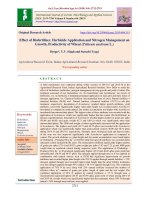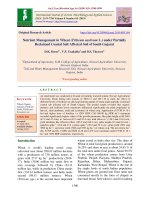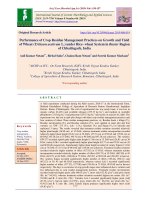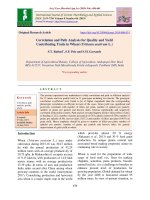Genetic divergence in wheat (Triticum aestivum L.Thell.) under saline sodic condition
Bạn đang xem bản rút gọn của tài liệu. Xem và tải ngay bản đầy đủ của tài liệu tại đây (209.22 KB, 9 trang )
Int.J.Curr.Microbiol.App.Sci (2017) 6(5): 181-189
International Journal of Current Microbiology and Applied Sciences
ISSN: 2319-7706 Volume 6 Number 5 (2017) pp. 181-189
Journal homepage:
Original Research Article
/>
Genetic Divergence in Wheat (Triticum aestivum L.Thell.)
Under Saline Sodic Condition
Manoj Kumar Pandey*, H.N. Bind, Sanjeev Kumar and B.N. Singh
Department of Genetics and Plant Breeding, ND University of Agriculture and Technology
Kumarganj, Faizabad-224229 (UP) India
*Corresponding author
ABSTRACT
Keywords
Divergence,
Euclidean cluster,
Grain yield, Wheat.
Article Info
Accepted:
04 April 2017
Available Online:
10 May 2017
Recently, abiotic stress like salinity, drought and temperature are the severe problems to
worldwide wheat production, mostly in arid and semiarid areas. A feasible solution is
breeding for salt-tolerant cultivars of wheat, while the presence of genetic variation is a
prerequisite for genetic improvement. In the present investigation, an experiment was
conducted to estimate the nature and magnitude of genetic diversity in improved varieties
of bread wheat during Rabi, 2010-11. Total number of 143 exotic and indigenous lines of
bread wheat including three checks was apprised in partially reclaimed salt affected soil
under late sown and irrigated conditions. The experiment was conducted in Augmented
Block Design having 7 blocks of 23 plots each, at Narendra Deva University of
Agriculture and Technology, Narendra Nagar (Kumarganj), Faizabad. All the wheat
germplam were grouped into twelve clusters by estimating genetic divergence of eleven
quantitative traits using the non-hierarchical Euclidean cluster analysis which showed the
highest inter-cluster distance between cluster VI and cluster XII. The genotypes having
high mean performance for grain yield per plant and several other yield components were
found to be concentrated in cluster IV and VI which merit showed due consideration for
selection of parents. Thus, crosses between promising lines belonging to cluster pair
having higher inter-cluster distances may be attempted for isolating transgressive
segregants as these cluster pair were also separated by high inter-cluster distances. The
twelve clusters formed in divergence analysis contained genotypes of heterogeneous
origin, thereby indicating non-parallelism between genetic and geographic diversity.
Therefore, crosses between the members of clusters separated by high inter-cluster
distances are likely to throw desirable segregates. This indicated existence of high degree
of genetic diversity in the wheat exotic and indigenous lines. Therefore, these exotic and
indigenous lines may serve as valuable source for selecting diverse parents for use in
hybridization programme.
Introduction
agricultural economy. Abiotic stress factors
such as cold, frost, drought, salinity, severely
limit plant growth and development as well as
the adaptability and mechanisms of plant
growth reducing yield in crops including
Wheat (Triticum aestivum L. em. Thell.) is a
major staple food in the world after rice and
primarily grown in tropical-temperate region
worldwide due to wide high adaptation and
greater role in human nutrition as well as in
181
Int.J.Curr.Microbiol.App.Sci (2017) 6(5): 181-189
cereals from the tribe Triticeae (Wang et al.,
2003, Kosová et al., 2014).
For obtain transgressive segregants, genetic
distance between parents is necessary (Joshi
et al., 2004) to estimate by Euclidean distance
(Hoque and Rahman, 2006). Germplasm
improvement and genetic diversity are useful
for reliable and sustainable production of the
food crops. For effective evaluation and
utilization of germplasm, measure of extent of
available genetic diversity is of utmost
importance (Zubair et al., 2007). The use of
multivariate statistical algorithms is an
important strategy for classification of
germplasm and analysis of genetic
relationships among breeding material
(Mohammadi and Prasanna, 2003). The aims
of the present study are investigation of
genetic diversity and identification between
selected genotypes and local cultivar of wheat
for salt tolerance by cluster distance analysis.
Salinity is the major threat to global wheat
production and effect about 6% of the world’s
area, particularly in arid and semiarid areas of
the world. Even in irrigated areas, salt
concentration increases in the subsoil due to
evaporation of water with the passage of time.
Saline soils have soluble salts responsible for
reducing economic importance and yield of
crop (Munns and James, 2003). Such a large
salt-affected area and economical loss is
major problems for farmers facing a decline
in their income that poses a threat to national
and international food security. Possible
solutions include increasing the area under
wheat cultivation and developing superior
varieties that provide a good yield under
saline condition. In arid and semiarid areas,
yield can be increased significantly by
developing salt-tolerant crop varieties (Clark
and Duncan, 1993) by exploiting genetic
diversity for salt tolerance in species and
developing screening techniques.
Materials and Methods
In the present investigation experiment
material consisted of 140 exotic and
indigenous wheat germplasm lines and three
check varieties viz., KRL-210, NW-2036, and
NW-1067 with pedigree (Table 1) collected
from genetic stock available in Wheat
Section, Department of Genetics and Plant
Breeding, Narendra Deva University of
Agriculture and Technology, Kumarganj,
Faizabad. The experiment was carried out in
Augmented Block Design in semi-arid region
of Faizabad during Rabi 2010-11. The entire
experimental field was divided into 7 blocks
of equal size and each block having 23 plots.
Out of 23 plots in a block, 20 plots were used
for accommodating the test genotypes which
were not replicated while remaining 3 checks
i.e. KRL-210, NW-2036, NW-1067 which
were replicated in three rows plot of 3 m long
with inter and intra-row spacing of 25 cm and
5 cm, respectively. Experimental site was
reclaimed salt affected soil having EC 0.39,
pH >8.5, ESP <15 and rich in potash and low
in organic carbon, nitrogen and phosphorus.
New genetic sources require developing
tolerance to salinity in crops under various
breeding programs. Hence, salt tolerant
cultivars/genotypes of wheat should be
needed to sustain for high yield production
under salinity condition (Munns, 2005).
Diversity can ensure sustainability and
improvement in the livelihoods of farmers in
unfavorable
environmental
conditions
providing high yielding crop varieties with
important useful traits.
Selection and hybridizations techniques are
frequently used for improving genetic
constitution of a genotype. Genetic
divergence analysis is important tool to
estimate genetic diversity among selected
genotypes
which
determine
family
relationships and genetic affinity or distance
of genotypes from each other studying cluster
analysis (Mellingers, 1972).
182
Int.J.Curr.Microbiol.App.Sci (2017) 6(5): 181-189
Recommended dose of fertilizers N:P:K @
150:60:60 and cultural packages were applied
to raise a good and healthy crop. The
observation were recorded from five
randomly selected plants for all the
quantitative characters viz., plant height (cm),
number of productive tillers plant-1, spike
length (cm), peduncle length (cm), grains
spike-1, 1000-grain weight (g), biological
yield plant-1 (g), grain yield plant-1 (g),
harvest index (%), flag leaf area (cm2) except
days to maturity, which was recorded on the
plot basis. Cluster analysis was done by using
Tocher’s method (Rao, 1952) and genetic
divergence of the pooled data of all the
genotypes analyzed by Mahalanobis (1936)
D2 statistics. The genetic divergence among
the wheat varieties were calculated by
canonical (Vector) and non-hierarchical
Euclidean methods of divergence estimation.
The D2 values were calculated by using the
method described by Mahalanobis (1936).
Genetic divergence analysis using canonical
(vector) method is a sort of multivariate
analysis where canonical vector and roots
representing different axes of differentiation
and the amount of variation accounted for by
each of such axes, respectively, were derived
(Rao,1952). Non- hierarchical Euclidean
cluster analysis (Beale, 1969; Katyal et al.,
1985) was conducted using computer package
(Windostat version 8.5).
cluster VII (18 genotypes), while minimum
numbers of genotype grouped in cluster VI
(only 4 genotypes) (Table 2). The highest
intra-cluster distance was observed in cluster
V (D2 = 81.46), followed by cluster VI (D2 =
78.77) (Table 2). The lowest intra-cluster
value was recorded for cluster X (D2 = 43.93),
followed by cluster VII (D2 = 44.38). Zaman
et al., (2005) observed diversity with high
range of values of inter and intra cluster
distance among wheat genotypes under Inter
cluster distance is important to screen
genotypes using D2 analysis Singh et al.,
(2013). Genotypes belonging to those clusters
showing higher inter cluster distance
considered genetically more divergent and
hybridization between these genotypes of
dissimilar clusters is likely to generate broad
variability with desirable sergeants Gartnar et
al., (1989) and Singh et al., (2006). The
analysis of variance exhibited significant
variation among the genotypes for all the
quantitative characters.
The maximum generalized inter cluster
distance (D2) was recorded between cluster
VI and XII (D2 = 1495.20), followed by
cluster VI and VII (D2 = 1017.754). Thus,
hybridization between genotypes from these
clusters may result in maximum hybrid vigour
and highest number of useful segregates Shwi
et al., (1972).The minimum inter-cluster
distance was found between cluster VII and
VIII (D2 = 74.95) followed by cluster VII and
IX (D2 = 76.50) indicating that the genotypes
in these two clusters were relatively close to
each other.
Results and Discussions
The non-hierarchical Euclidean cluster
analysis was studied to survey the genetic
divergence among 143 wheat germplasm on
the basis of 11 quantitative characters. The
pseudo F-test revealed that 12 nonoverlapping cluster arrangements were the
most appropriate for grouping all the
genotypes (Table 1). Among the evaluated
genotypes in saline sodic condition, the
maximum numbers of genotype were grouped
in cluster II (21 genotypes) followed by
On the basis of average cluster mean values
(Table 3) for 11 characters, the genotype of
cluster IV showed maximum divergence for
peduncle length (31.293), spike length
(10.948), grains per spike (41.489), biological
yield per plant (23.214) and grain yield per
plant (8.736).
183
Int.J.Curr.Microbiol.App.Sci (2017) 6(5): 181-189
Table.1 Clustering pattern of 140 wheat genotypes on the basis of non-hierarchical Euclidean cluster analysis of 11 characters
Cluster
No .
No . o f
genotypes
Name of genotypes
15
42ndIBWSN-1023, KRL-210, 42ndIBWSN-1119, 27thSAWSN-3052, 30th ESWYT-131, 42nd IBWSN-1175-II, 29thESWYT-136, EC-663946,
27thSAWSN-3082, EC-664193, 42ndIBWSN-1107, 19thHRWSN-2026, 27thSAWSN-3107, 1stCSISADRYT-5217, 29thESWYT-130.
21
42ndIBWSN-1121, 42ndIBWSN-1166, 4thSAMNYT-411, KRL-302, 27thSAWSN-3097, 1stCSISADRYT-6764, 42ndIBWSN-1152,
1stCSISADRYT-5218, 30thESWYT-118, 1stCSISADRYT-5212, 27thSAWSN-3011, EC-663954, EC-664196, EC-664244, IC-524282, IC524284, EC-664236, 27thSAWSN-3027, 27th SAWSN-3069, ESRN-51, 42ndIBWSN-1158.
14
42ndIBWSN- 1113, EC-634300-88, KRL-301, KRL-312, 10thEGPYT-7, KRL-315, 1stCSISADRYT-6767, EC-664009, 1stSATYN-60, IC553917, 1stSATYN-26, EC-663961, KRL-306, 10thDSBWYT-407.
12
42ndIBWSN- 1151, EC-634300-106, EC-634300-103, EC-634300-81, 1st SATYN-45, 42ndIBWSN -1150, 42nd IBWSN-1038-II, 42nd
IBWSN-1057, 1stSATYN-37, 1stSATYN-35, 1stSATYN-38, IC-546933.
V
6
42ndIBWSN- 1173, 10thEGPYT-11, 1st SATYN-46, 1stSATYN-53, 10thDSBWYT-420, 42ndIBWSN 1175-I.
VI
4
EC-634300-69, EC-634300-99, EC-634300-64, EC-634300-110.
18
42ndIBWSN -1034,16th HRWYT-206, EC-664229, 4thEBWYT-511, EC-664208, EC-664200, 42ndIBWSN-1112, 27thSAWSN-3004,
42ndIBWSN-1038-I, 42ndIBWSN-1170, ESRN-11, NW-1067, 42ndIBWSN-1039, EC-634300-76,GW-2008-156,GW-2007-87,GW-2007-92,
EC-664189.
VIII
8
29thESWYT-110, EC-634300-95, RAJ-4211, NW-5029, GW-2008-157, NW-2036, 42ndIBWSN-1087, EC-664215.
IX
10
IC-524288, WH-1083, ESRN-15, KRL-307, KRL-322, ESRN-3, 10thDSBWYT-422, KRL-305, KRL-299, GW-2008-153.
9
42ndIBWSN-1164, KRL-309, EC-634300-82, KRL-323, 42ndIBWSN -1146, 42ndIBWSN-1167, 42ndIBWSN-1169, 12th EGPSN-51, 42nd
IBWSN-1065.
11
30thESWYT-119, 42ndIBWSN-1021, 1stSATYN-23, WH-1097, 4th EBWYT-509, KRL-300, IC-549914, EC-414149, KRL-303, KRL-304,
42ndIBWSN-1137.
15
42ndIBWSN-1063, KRL-324, EC-664199, 42ndIBWSN -1103, EC-634300-133, EC-664227, LBP-2009-24, KRL-316, GW-2008-159, GW2006-17, GW-2007-96, EC-634300-94, EC-634300-63, RWP-2009-12, GW-2007-80.
I
II
III
IV
VII
X
XI
XII
184
Int.J.Curr.Microbiol.App.Sci (2017) 6(5): 181-189
Table.2 Estimates of average intra and inter- cluster distances for 12 clusters in exotic and indigenous lines of wheat
Cluster no.
I
II
III
I
107.919
207.148
50.459
II
129.939
64.726
III
61.992
IV
V
VI
VII
VIII
IX
X
XI
XII
Bold figures indicate intra–cluster distances.
IV
184.839
127.409
84.273
51.732
V
417.185
203.186
193.024
210.339
81.46
VI
783.524
475.977
492.581
440.298
188.211
78.769
VII
143.680
221.040
174.211
205.062
534.267
1017.754
44.381
VIII
81.681
153.341
180.486
207.749
472.904
921.181
74.957
46.170
IX
199.293
207.827
113.419
176.660
405.757
874.149
76.500
110.919
49.220
X
99.952
136.471
141.786
111.925
377.517
756.484
110.332
119.362
131.383
43.928
XI
200.399
261.090
166.004
153.766
519.219
944.062
82.788
147.435
104.060
97.459
53.777
XII
245.049
405.992
381.173
442.735
858.093
1495.208
109.961
136.426
173.591
240.134
199.403
67.654
Table.3 Cluster means for different characters in exotic and indigenous lines of wheat
Cluster
Flag leaf
Days to
Peduncle
Plant height
Spike length
Grains
number
area (cm²)
maturity
length (cm)
(cm)
(cm)
per spike
I
II
III
IV
V
VI
VII
VIII
IX
X
XI
XII
19.723
18.570
19.391
20.352
18.885
20.550
21.525
22.334
18.616
22.662
19.618
18.699
125.400
124.952
124.357
123.833
125.500
125.250
124.000
124.375
124.900
125.444
125.455
123.733
29.226
29.548
27.720
31.293
30.250
26.425
30.061
30.425
28.510
30.183
29.755
30.127
81.493
82.694
79.753
85.035
80.848
76.200
81.853
85.563
80.814
84.429
81.753
81.390
10.398
9.950
9.883
10.948
9.418
9.605
9.924
9.628
10.201
10.469
10.422
9.403
40.629
38.673
39.494
41.489
38.660
39.323
39.564
38.520
40.225
40.177
40.440
38.449
185
Reproductive
tillers per
plant
4.879
4.879
5.118
5.282
4.817
5.525
4.568
4.940
5.140
4.827
4.785
4.736
1000 grain
weight (g)
39.343
39.770
40.336
39.565
40.107
40.520
39.589
39.112
39.453
41.013
41.079
39.699
Biological
yield per
plant(g)
20.484
19.982
21.038
23.214
19.345
22.860
18.987
19.336
20.514
21.208
20.706
18.912
Grain yield
Harvest
per plant(g)
index(%)
7.823
7.591
8.155
8.736
7.427
8.705
7.161
7.454
8.121
8.150
7.916
7.255
38.117
37.892
38.779
37.587
38.590
38.033
37.817
38.425
39.568
38.433
38.299
38.429
Int.J.Curr.Microbiol.App.Sci (2017) 6(5): 181-189
Table.4 Diverse and superior genotypes with desirable traits selected from different clusters
SN
Characters
Genotypes
1.
Flag leaf area (cm²)
GW 2007-80, ESWYT-110, KRL-315, GW 2008-153, 1CSISADRYT-5217, RWP 2009-12, IBWSN-175,
1SATYN-53, IBWSN-34, IC-524284
2.
Days to maturity (Early)type
IC-546933, GW 2008-157, GW 2008-156, EC-634300-99, GW 2007-92, KRL-315, EC-634300-64, IC549914, IC-524288, EC-664236, EC-634300-110
3.
Peduncle length (cm)
IBWSN-103, IBWSN-63, EC-634300-63, 43IBWSN-1107, EC-664199, EC-664189, EC-634300-133, EC634300-95., ESWYT-110, IBWSN-137, IBWSN-112
4.
Plant height (cm) (Dwarf)
EC-634300-133, EC-634300-94, IBWSN-103, IBWSN-63, GW 2006-17, RWP 2009-12, KRL-324, GW
2008-159, GW 2007-96., LBP 2009-24, EC-634300-63
5.
Spike length (cm)
10EGPYT-11, EC-664236, GW 2008-153, 10DSBWYT-420, 27SAWSN-3027, ESRN-51, 27SAWSN-3069,
EC-663954, EC-634300-110, EC-664244, EC-664215
6.
Grains per spike
27SAWSN-3027, 27SAWSN-3069, ESRN-51, EC-664236, EC-634300-63, EC-664196, 10DSBWYT-420,
GW 2008-153
7.
Reproductive tillers per plant
IC-524282, GW 2008-157, 29ESWYT-130, IC-524284, 43IBWSN-1107, EC-664236, 29ESWYT-136, IC553917, EC-634300-110, EW-EC-664215, NW-5029
8.
1000- grain weight (g)
45IBWSN-1175, 1CSISADRYT-5218, IBWSN-152, ESRN-51, 27SAWSN-3107, 30ESWYT-131, KRL-323,
43IBWSN-1107, 29ESWYT-130
9.
Biological yield per plant (g)
EC-664236, EC-634300-110, 29ESWYT-130, IC-524282, IBWSN-158, 27SAWSN-3107, 1CSISADRYT5217, EC-664244, EC-663946, EC-664215
10.
Harvest index (%)
KRL-306, EC-663961, 1SATYN-46, GW 2007-80, 1SATYN-60, 29ESWYT-130, 1SATYN-26 EC-63430094, NW-5029, EC-634300-76
11.
Grain yield plant (g)
-1
29ESWYT-130, IBWSN-158, 27SAWSN-3107, EC-664236, EC-634300-110, IC-524282, 19HRWSN-2026,
1CSISADRYT-5217, 43 IBWSN-1107, 27 SAWSN-3027
186
Int.J.Curr.Microbiol.App.Sci (2017) 6(5): 181-189
Others traits viz., flag leaf area (22.662), days
to maturity (125.500), plant height (85.563),
reproductive tillers per plant (5.525), 1000
grain weight (41.079) and harvest index
(39.568) exhibited maximum cluster mean in
the cluster X, V, VIII, VI, XI and IX,
respectively. Whereas, cluster XII, contained
four traits and cluster VI and VII bear two
trait, which exhibited minimum cluster mean
values and cluster II, IV, VIII, consisted of
only one trait which exhibited minimum
cluster mean values. These results are in
conformity with those obtained by
Hailegiorgis et al., (2011) for grain yield.
Based on cluster means, cluster IV has been
identified for selecting parents
for
incorporating peduncle length, spike length,
grains per spike, biological yield per plant and
grain yield per plant. Similar grouping of
genotypes has also been reported by Bergale
et al., (2001). The present study confirms the
findings of Verma et al., (2014), who grouped
108 wheat genotypes into eleven clusters
based on their various morpho-agronomic
traits. The identified genotypes superior in the
above cluster may be involved in a multiple
crossing programmes to recover transgressive
segregants with high genetic yield potential.
Evaluation of genetic diversity can be useful
for the selection of the most efficient
genotypes (Table 4). Accordingly, if such
efforts result in the reduction of diversity,
production of plants with higher uniformity
may guarantee the production of enough food
for the world increasing population.
genotypes may be used as donor in various
hybridization programmes to improve yield
under sodic soil created saline stress
environment. Earlier studied have also
reported substantial genetic divergence in
wheat (Deshmukh et al., 1999; Roy et al.,
2004; Verma et al., 2006; Singh et al., 2006;
Iqubal et al., 2007). The cluster pattern of the
genotypes showed non-parallelism between
geographic and genetic diversity (Singh et al.,
2009). The statistical analysis revealed that
the diverse clusters showed high inter cluster
distances which might generate a wide range
of transgressive segregants for development
of high yielding wheat varieties (Kumar et al.,
2015). High degree of genetic divergence
observed in the present study on the analysis
of all the wheat genotypes.
In conclusion the existence of considerable
significant genetic variations was acquired
among the genotypes for all the eleven
selected quantitative characters under sodic
soil condition, which may help for further
selection and breeding. Identified superior
genotypes may be selected from those clusters
which had significant genetic distance for
crossing in order to obtain genetic
recombination and transgressive segregation
in the subsequent generations. Results are
important to contrast to the sodic soil
conditions will assist breeding programs to
identify tolerant genotypes under sodic soil
conditions.
References
The grouping of genotypes reveled that
indentified tolerant genotypes may be used as
donor in various hybridization programmes to
improve yield under sodic soil created saline
stress environment. Earlier studied have also
reported substantial genetic divergence in
wheat (Deshmukh et al., 1999; Roy et al.,
2004; Verma et al., 2006; Singh et al., 2006;
Iqubal et al., 2007). The grouping of
genotypes reveled that indentified tolerant
Beale, E.M.L. 1969. Euclidean cluster
analysis, A paper contributed to 37th
session of the Indian National Statistical
Institute.
Bergale, S., Billore, M., Holkar, A.S., Ruwali,
K.N., Prasad, S.V.S. and Mridulla, B.
2001. Genetic variability, diversity and
association of quantitative traits with
grain yield in bread wheat (Triticum
187
Int.J.Curr.Microbiol.App.Sci (2017) 6(5): 181-189
aestivum L.). Madras Agri. J., 88(7-9):
457-461.
Clark, R.B. and R.R. Duncan. 1993. Selection
of plants to tolerate soil salinity, acidity,
and mineral deficiencies. Int. Crop Sci.,
1: 371–9
Department of Food and Public Distribution
(DoFPD). Department of Commerce
(DoC); Directorate of Economics and
Statistics (DES); Department of
Agriculture and Cooperation (DoAC).
Deshmukh, P.B., Atale, S.B., Pandey, M.K.,
Vithare, D.G. and Golhar, S.R. 1999.
Genetic divergence in durum wheat.
Crop Improv., 26(1): 95-98.
Federer, W.T. 1956. Augmented Designs.
Hawain Planters Record, 40: 191-207.
Gartnar, S.L., Tomer, Y.S. and Singh, V.P.
1989. Genetic divergence in early
maturing pigeonpea. India J. Pulses
Res., 2: 25-31.
Hailegiorgis, D., M. Mesfin and T. Genet,
2011. Genetic divergence analysis on
some bread wheat genotypes grown in
Ethiopia. J. Cent. Europ. Agric., 12(2):
344-352.
Hanson, G.H., Robinson, H.F., and
Comstock, R.E. 1956. Biometrical
studies of yield in screening populations
of Korean Lesoedeza. Agron. J., 48:
268-272
Hoque, M., Rahman, L. 2006. Estimation of
Euclidian distance for different morphophysilogical characters in some wild
and cultivated rice genotypes (Oryza
sativa L.). Pak. Sci., 1: 77- 79.
Iqubal, A., Khan, A.S., Khan, I.A., Awan,
F.S., Ahmad, A. and Khan, A.A. 2007.
Study of genetic divergence among
wheat genotypes through random
amplified polymorphic DNA. Genetics
and Mol. Res., 6(3): 476-481.
Joshi, B.K., Mudwari, A., Bhatta, M.R. and
Ferrara, G.O. 2004. Genetic diversity in
Nepalese wheat cultivars based on
agromorphological
traits
and
coefficients of parentage. Nep. Agric.
Res. J., 5: 7-17.
Katyal, J.C., Doshi, S.P. and Malhotra, P.K.
1985. Use of cluster analysis for
classification of Benchmark soil
samples from India in different
micronutrient availability group. J.
Agric. Sci. Combridge, 104: 421-424
Kumar, R., Prasad, B. K., M.K. Singh, Singh,
G., and Verma, A. 2015. Genetic
divergence analysis for morphophysiological traits, under timely and
late sown condition in bread wheat
(Triticum estivum L.). J. Wheat Res.,
7(1): 27-30.
Mahalanobis, P.C. 1936. On the generalized
distance in statistics. Proc. Natl. Inst.
Sci., (India), 12: 49-55.
Mellingers, J.S. 1972. Measures of genetic
similarity and genetic distance. Studies
in genetics. VII Univ Tex. Publ., 27(13):
145-153.
Mohammdi, S.A. and Prasanna, B.H. 2003.
Analysis of genetic diversity in crop
plant salient statistical tools and
considerations. Crop sci., 43(4): 12351248.
Munns, R. 2005. Genes and salt tolerance:
bringing them together. New Phytol.,
167: 645-663.
Munns, R. and James, R.A. 2003 Screening
methods for salinity tolerance: a case
study with tetraploid wheat. Plant Soil,
253: 201–218
Rao, C.R. 1952. Advanced Statistical
Methods in Biometric Research. John
Wiley and Sons Inc., New York.
Roy, J.K., Lakshmikumaran, M.S., Balyan,
H.S. and Gupta, P.K. 2004. AFLPbased genetic diversity and its
comparison with diversity based on
SSR, SAMPL and phenotypic traits in
bread wheat. Biochemical Genetics,
42(1-2): 43-59.
Shwi, U.H., Murthy, B.R., Singh, H.B. and
Rao, U.M.B. 1972. Genetic divergence
188
Int.J.Curr.Microbiol.App.Sci (2017) 6(5): 181-189
in recent elite strains of soybean and
groundnut in India. Indian J. Genet.,
32(2): 285–298.
Singh, S.K., Singh, B.N., Singh, P.K. and
Sharma, C.L. 2006. Genetic divergence
of exotic germplasm lines in wheat (T.
aestivum L.). Indian J. Plant Genet.
Res., 19(2): 218-220
Singh, D., Singh, S.K., Singh, K.N
2009.
Diversity of Salt Resistance in a Large
Germplasm Collection of Bread Wheat
(Triticum
aestivum L.).
Crop
Improvement, 36(1): 9-12.
Verma, A.K., Singh, P.K., Vishwakarma, S.R.
and Tripathi, R.M. 2006. Genetic
divergence in wheat (T. aestivum L.),
Farm Sci. J., 15(1): 32-34.
Zaman, M.R., Paul, D.N.R., Kabir, M.S.,
Mahbub, M.A.A., Bhuiya, M.A.A.
2005.
Assessment
of
Character
Contribution to the Divergence for
some Rice Varieties. Asian J. Plant Sci.,
4(4): 388-391.
Zubair, M., S.U. Ajmal, M. Anwar and M.
Haqqani. 2007. Multivariate analysis for
quantitative traits in mungbean [Vigna
radiate (L.) Wilczek]. Pak. J. Bot., 39:
103-113.
How to cite this article:
Manoj Kumar Pandey, H.N. Bind, Sanjeev Kumar and Singh, B.N. 2017. Genetic Divergence
in Wheat (Triticum aestivum L. Thell.) Under Saline Sodic Condition.
Int.J.Curr.Microbiol.App.Sci. 6(5): 181-189. doi: />
189









